Do you want to bring a refreshing aroma to your garden and home? Learn all about How to Grow Lavender easily!
Lavender is a refreshing herb with multiple benefits. Every garden should have at least a few bushes of this pretty, purple, fragrant plant wherever possible! If you too want this fragrant specimen in your home and garden, learn all about How to Grow Lavender ahead!
Is It Possible To Grow Lavender In Tropics? Click here
Lavender Plant Information
Lavender is a perennial that can come back year after year. With upright gray-green foliage and purple flower spikes, it is a compact shrub that can add beauty and fresh aroma to your garden and home.
It is ideal for planting this herb in the spring after the risk of frost is over and the soil is warmer. The herb grows at a moderate pace and adds 3-6 inches yearly to its size.
Look at the Best Purple Houseplants here
Varieties of Lavender
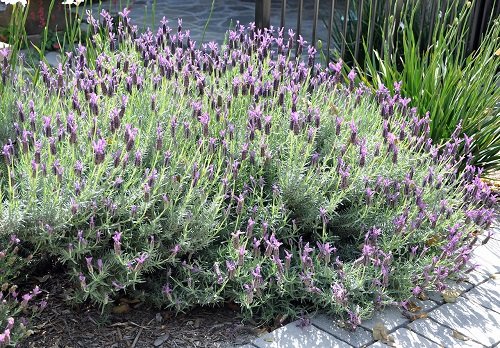
1. English Lavender
Lavandula angustifolia grows well in USDA Zones 5-8. You can also train it to grow over the hedge or anywhere of your liking where it gets plenty of sunlight.
2. Spanish Lavender
Lavandula stoechas comes from Mediterranean countries, also called top Lavender. It is a tender perennial, and looks very impressive with purple or white flowers that form a dome shape.
3. French Lavender
Lavandula dentata has a somewhat delicate scent. Its purple and spiky flowers match really well with the light green foliage.
Find out the Best Lavender Varieties here
Propagating Lavender
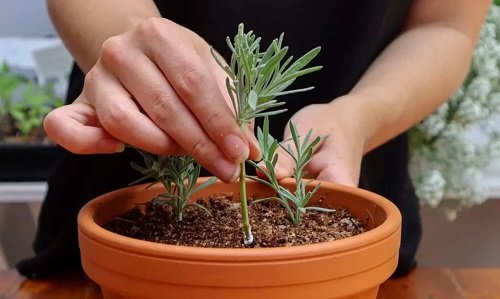
It is best to propagate the Lavender plant with either softwood or hardwood cuttings. Softwood cuttings are the flexible, soft tips of the shoot available in spring, while hardwood cuttings are the shoot parts with woody stems available in fall. Follow these steps to propagate quickly:
- Cut a 3-4 inch segment from a healthy, mature shoot using a clean, sharp knife. Hardwood cuttings should be made just below a small bump, the leaf node.
- Get rid of all the leaves from the bottom 2-3 inches of the cuttings.
- Plant the cutting in a container filled with moist seed-starting mix.
- Use a clear plastic bag to cover the container and place it in a spot that receives 6-8 hours of filtered sunlight. Softwood cuttings will begin to root in 2-4 weeks, and the hardwood ones can take a bit longer.
Learn about Growing Lavender from Cuttings here
Requirements For Growing Lavender
Light
The key to growing lavender lies in the right amount of sunlight. It is essential that the herb gets a minimum of 5-6 hours of bright and direct sunlight on a daily basis. This will not only promote blooming but will also keep the plant bushy.
Do not keep the plant in a shady spot, as it will result in fewer or nil flowers with no fragrance.
Soil
Lavender prefers to grow in well-draining soil without much organic matter. A slightly alkaline growing medium with a pH between 6.7 and 7.3 will boost the growth.
Adding a handful of sand in the soil will promote drainage, as lavender hates to sit in a waterlogged growing medium.
Water
Lavender is one of the resilient herbs that is highly drought-tolerant once established. Water only when the topsoil feels a little dry to the touch, but at the same time, do not let the growing medium dry out completely.
Avoid watering the plant daily.
Temperature and Humidity
The best temperature range to grow this herb is 68-86°F (20-30°C) from spring to early summer. Temperatures above 65°F (18°C) produce the best growth and flowers.
Find out the Best Flowering Houseplants here
Lavender Plant Care
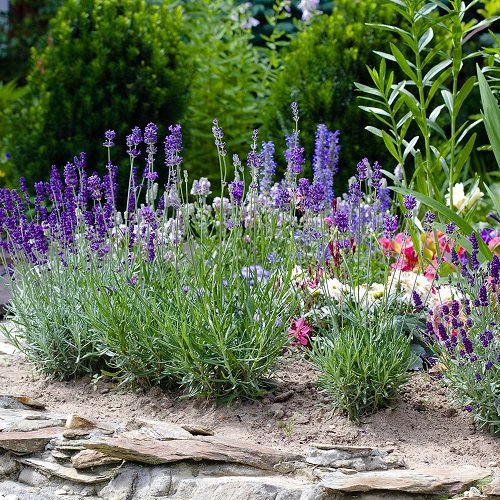
Fertilizer
It is ideal for adding a handful of compost into the growing medium at the time of planting. To promote flowers, use a balanced liquid fertilizer, diluted to 1/2 of its strength, once in 6-7 weeks.
Pruning
Pruning lavender is important to encourage new growth and flowers.
Ideally, you should prune the plant once in the spring at the beginning of the growing season (soft pruning) and once after the end of the blooming period.
If your plant is small and has no flowers, it doesn’t need pruning. But if the plant is big and shrubby, prune it after the flowering when the flowers lose their color in late summer; grab the bush and neatly cut it back to 1/3 of its height.
Diseases and Pests
Pests like spider mites, spittlebugs, leafhoppers, and whiteflies can attack the plant. Resort to neem oil and insecticidal soaps to get rid of these pests.
Although this herb is not affected by many diseases, it can develop phytophthora, a fungal disease causing stem and root rot. Lavender can also easily be susceptible to septoria leaf spots caused by a fungus found on tomato plants.
To keep it safe from potential diseases, avoid overwatering and keep it at an airy location.
Check out the Best Perennial Herbs here
Harvesting Lavender
One of the primary reasons you should grow Lavender is the soothing fragrance that it emits. Harvest the flower as soon as the buds open up for the best results.
Hang them in smaller bunches upside-down in a dry, warm location with good ventilation until dried.
Lavender flowers are edible and can be used raw in salads, soups, and stews, baked into cookies, and cakes, brewed into an herbal tea, and used as a seasoning herb.
Find the Herbs that Grow from Cuttings here
Lavender Uses
Lavender plant has many health and culinary uses, and here are some of the benefits of Growing Lavender:
- Stops Hair Loss
- Soothes Wounds and Pain
- Tames Your stomach
- Salt Substitute
- Helps Treat Burns
- Soaks Up Toxins
- Freshens Your Floors
- Eases Motion Sickness
- Treats Eczema and Dry Skin


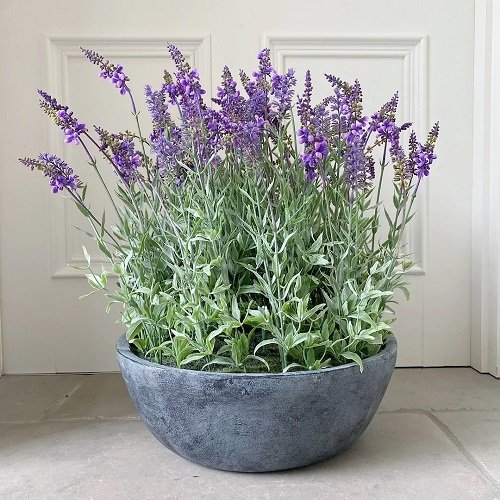

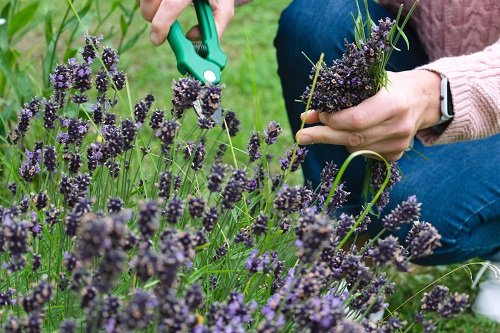


Couple things I learned about lavender: grows best where your auto sprinklers can’t reach. Loves ‘hot’. That’s why it grows nicely next to a sidewalk or a gravel path. If it’s happy, it seeds itself. Use tiny plants to replenish when old plants look tired. Trimming is essential if you want it be happy.
And don’t do what I did only once, because all my neighbors thought I’d started a wild fire! Never use your ‘propane weed burner’ anywhere near lavender! It is full of oil and goes up like a bomb!
Secondly, grow enough to share. Folks will stop and ask. It’s a great conversation starter. We’ve shared many a glass of wine on the front porch over lavender sharing! Enjoy!
Did you ever notice how gardeners talk about plants as friends they cherish?
Love your tips and story! Thank you!
Agree 100% I sip wine while I have a plant conversation with hubby! And now neighbors plants bring such a nice vibe to your home !!
Disagree, herein AZ my lavender are sprinkled twice daily 24/7 365 and they thrive.
Thank you so much! It is definitely an wonderful web site.
Great information. I’m excited about planting lavender. Thank you very much!
Can lavender be grown in pots?
I’m in hot, dry El Paso. I have sandy soil, but everything seems to wilt even after watering every other day. What can I do? 7% humidity here, at about 3700 ft.
I’m in EP too, i’ve tried lavender several times always died in the pot. I’m going to phone in and ask the master gardeners on the ‘good to grow’ radio program on Saturday morning at 88.5 fm
I grew Lavender in El Paso Texas. It loves the heat. I planted French lavender, base soil was a good darrk soil which I covered in a mount of sand. I watered often until the plant was established and then reduced the water to avoid rot. My lavender grew into a huge shrub and thrived for many years. Now I live in Kentucky and can’t grow it here at all. It keeps dying no matter what I do.
Lucky you! I live in a zone 5 and planted about 10 lavender plants that were already fairly mature , They came iin plastic pots from a reputable nursery and we had two different types ( both purple) but one grew better than the other and even lost a few which we replaced. I was so excited to have a long and slightly curvy area to plant them with plenty of sun. One side was the concrete patio walkway and then two feet or so of dirt with a stone wall on the other side! Sounds good, right! Well, those poor lavenders did not do well at all!! I don’t know if it was the dirt or is oil insects or too wet but it was a sad 1st year! I am watching to see what Winter has done and will try again! I don’t know what we did wrong? I had grown lavender at a past house and that did wonderful! Any ideas or suggestions so we can have a walkway of lavender like the beautiful pictures show! Thanks and happy gardening!!!!
Maybe test the ph level of the soil it’s growing in. The article specified it liked a ph of 6.5-7.5 at the very top of the article.
It seems that only at the first few weeks after planting lavender, it requires to be watered (the soil cannot be dried), but soil has to drain well. It likes sand soil and not rich.
My beginner lavender plant died in its pot. I had good soil and plenty of sun light. Thoughts?
I live in southern Ontario. I love lavender. Can I plant it even though you say zone 5. I think we are in zone 4.
I also live in southern ON and my lavender plants thrive. I planted them by my driveway where there is a retaining wall. I give them plenty of compost, thourough water only when dry and a heavy pruning in the spring. The smell is so relaxing and makes you smile as you come home.
If you are in Windsor or south, you are south of Detroit which is Zone 5. Sandy soil mounded, mild trimming. The lake effect will help, but only with South winds. you may need more sun, so if indoors, South window.
Intermitent water, never daily. Speciman plants best, no crowding. Ex-detroiter, now colorado.
I am in South Carolina. For the first time I decided to buy couple of lavender plants. I put them in a pot of lofty soil and in the sun. I have had them almost two months now and they have not grown at all!!!!! They are literally doing NOTHING!!! About 6″ tall and holding! HELP!!!!!!
I grew lavender very successfully in Toronto. Over-wintered very well for last 7 years. Needs pruning to stay happy.
Hi just Abit curious did u have lavender or lavendulas and how did u care for it over winter to come back . I have very little luck with that please and thankyou
Many thanks very practical. Will share site with my pals.
I’m in Louisiana. How does lavender grow here? I love the smell and beauty of this plant. Any thoughts on my zone?
Thank you! I’ve always loved my lavender, but never knew about pruning. My lavender is just a few giant, unruly, colorless shrubs that smell gorgeous. I live in very hot and humid West Virginia but we also get icy Nor’easters.
Can’t wait to get put there (when it cools down) and take my lavender back! :)
I live in Iceland and am trying to grow lavender but I never suceed…why I don’t know?
I read the article because I saw the picture of the lavender plant pruned into a tree form. Which variety did you do this with? How did you do it!? I loved the effect!!
I live in the midlands uk and my lavender plants are huge plenty of flowers full of bees lovely to watch
One tip I have for zone 6b is to NOT use wood mulch. Always add some sand for mulch every year.